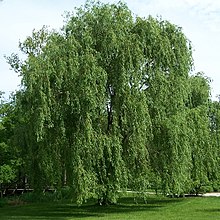Botanical Characteristics of Willow:
– Willows belong to the genus Salix in the family Salicaceae.
– They have stipules at the base of the petiole and watery bark sap with salicylic acid.
– Leaves are elongated, round to oval, with serrated edges.
– Flowers are dioecious, with male and female flowers on separate plants appearing as catkins in spring.
– Willows are classified into subgenera based on morphological and phylogenetic studies.
– The oldest fossils of willows date back to the early Eocene.
Cultivation and Uses of Willow:
– Willows root easily from cuttings or broken branches and are extensively cultivated worldwide.
– They are used in hedges, landscaping, and have various hybrid species like Salix alba and Salix cinerea.
– Willow bark has been historically used by various cultures for medicinal purposes.
– The cultivation of willows is important for bioenergy production and ecosystem services.
– Willow bark has been experimented with for fever treatment and rheumatism.
Manufacturing and Horticultural Applications of Willow:
– Willow wood is traditionally used in manufacturing cricket bats, fishing nets, baskets, furniture, and other items.
– Willow bark extract is used as a fungicide in horticulture for controlling plant diseases.
– It is approved for use on various crops like grapes, apples, and peaches to control diseases like scab and powdery mildew.
– Willow is woven into wicker for crafts like baskets, fish traps, and house walls.
– Willow bark extract is also used in biofiltration of wastewater and land reclamation.
Environmental Impact and Cultural Significance of Willow:
– Willows have invasive potential in some regions and can impact local ecosystems.
– They are used in environmental applications like wastewater treatment and phytoremediation.
– Willows have cultural significance in various traditions and mythologies around the world.
– They are associated with festivals like Sukkot and ceremonies in different religions.
– Willows have been mentioned in ancient texts, literature, and art, influencing cultural beliefs and narratives.
Research and Publications on Willow:
– Various books and studies explore the taxonomy, genetics, and relationships among different willow species.
– Research has contributed to understanding the diversity and characteristics of the genus Salix.
– External resources and links provide further information on willows in academic and reference materials.
– Studies focus on the environmental applications of willows, including phytoremediation and bioenergy production.
– The historical and medicinal significance of willow continues to be a subject of research and exploration.
Willows, also called sallows and osiers, of the genus Salix, comprise around 350 species (plus numerous hybrids) of typically deciduous trees and shrubs, found primarily on moist soils in cold and temperate regions.
| Willow Temporal range:
| |
|---|---|

| |
| Salix alba 'Vitellina-Tristis' Morton Arboretum, Lisle, Illinois | |
| Scientific classification | |
| Kingdom: | Plantae |
| Clade: | Tracheophytes |
| Clade: | Angiosperms |
| Clade: | Eudicots |
| Clade: | Rosids |
| Order: | Malpighiales |
| Family: | Salicaceae |
| Subfamily: | Salicoideae |
| Tribe: | Saliceae |
| Genus: | Salix L., nom. cons. |
| Type species | |
| Salix alba | |
| Diversity | |
| About 350 species | |
Most species are known as willow, but some narrow-leaved shrub species are called osier, and some broader-leaved species are referred to as sallow (from Old English sealh, related to the Latin word salix, willow).
Some willows (particularly arctic and alpine species) are low-growing or creeping shrubs; for example, the dwarf willow (Salix herbacea) rarely exceeds 6 centimetres (2+1⁄2 in) in height, though it spreads widely across the ground.
